|
| ||||||
Special | A | B | C | D | E | F | G | H | I | J | K | L | M | N | O
P | Q | R | S | T | U | V | W | X | Y | Z | ALL
A |
|---|
Alaska Longspur: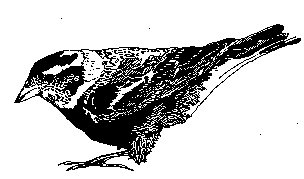
Chilu{ - Calcarius lapponicus Chilu{, saaqudgim sakuchaa aza{. Uku}aqa}ulax aguun qanikinga masxal aguun udaa}al qayas ilan hawang aku{ uku}aqaliza{. Slum aslaan, chilum ali}ingis angaacha}il tutaatuna{ agu{tal haang azas. Chilum ali}igan kamgii qaxchikda{ ama chumnugim qaxchikdaa ama quhma{ angali{taza{. Chilum ali}igan hiiyukaa chumnugiku{ ilidaa quhmaza{. Aqadaguun chilum ayagagan hakangis chumnugim qaxchikdaa ama quhma{ angali{tazas. Slum aslaan udang al saahmla}il aqadagudix saaqudikinga masxal aguun, ilagaan hawaa}aqamdix hadan huyaa}utazas.
Alaska Longspur - Calcarius lapponicus A longspur is strictly a summer bird. It is only seen in the summer. Longspurs are seen starting to arrive in the spring and they can be seen up in the hills. The drake longspur likes singing, and it has a very nice sounding song. The drake longspur has a black, brown and whitish head, a white chest and a yellow bill. The hen, on the other hand, has kind of brownish and white colored feathers. The longspur spends the summers here and they lay eggs, and they have their young. When fall comes, they head back to where they came from. |
Ancient Murrelet: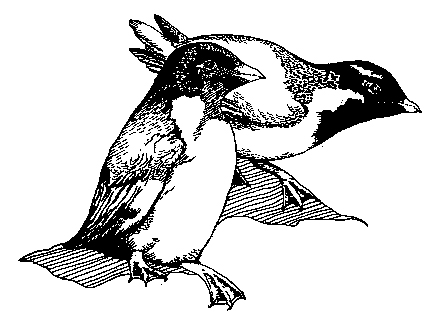
Qizangi{ - Synthliboramphus antiquus Qizangi{, salaayakucha{ aku{. Ala}um kugan slum aslaan hasinakuchal haang akus uku}azas. Sakucham quuhmliigii aku{ kamgii qaxchikdaku{, uyugan ilagaan atxulii akiita{ quhmaza{. Kitakix ama hiiyukaa ila{taa qaxchikdaza{. Slum aslaan tan}is kugan tanam sinigan huna{ agu{tal ilan saahmala}izas, hagumatakus cha}il igulgazaqas a{tazakus. Wayaam haqaya}azalaka}is. Saahmlangis kuuricham saahmlaa as txidix aagiikal hiila{tazas. Slum aslaan hasinanas agudix, qan'gim ngaan ixchil uku}aqadazas. Slum sangis akus mal, slum aslaan udang alanakuchaza}ulas. Agiichigaan kalu}talgal qalgazakus.
Ancient Murrelet - Synthliboramphus antiquus The ancient murrelet is a very small duck. It is seen in great numbers during the summers. The murrelet is a small grayish bird with a black head. It has white feathers from its throat to its belly. The bill and feet on a murrelet is black in color. During the summers, the ancient murrelets nest on islets in burrows they build for that purpose. In the past, the murrelets and eggs were gathered by hand just by grabbing them while they were nesting in their burrows. Today, this is not done like it was in the past. The eggs of ancient murrelets are large. The egg is approximately the size of a chicken's egg. During the summers, the ancient murrelets are plentiful, and when fall comes, they head back to where they came from. |
B |
|---|
Bald Eagle:
Ti}Ia{ - Haliaeetus leucocephalus Ti}la{, sal}uk aku{, agacha qalgaza}ulax. Kaznam saa hiila{tazaku{, maalal ana{ maalal kalulgal asxuunulax, ana}is maaIaadahIiika}ula{. Kalukuun txin hi{saalal aguun txin hachisxaa}an a}na{. Ti}Ia{, sam qaxchikdana{ liidaa aku{, kamgii ama hitxigan hakangis quhmaza{ ama hiiyukaa ama kitakix chumnugim angalidigaa angali{taza{. Kitagan qagal}ingis qichi}iku{ suktal qaqamii}uza{. Hakang inkam ilan iga{tal qas agisa}iisal angali{ aguun, hakaax kims qam an}a}ii kita}iisal suza{. Hingamaku{ mal slum aslaan Chi}anam qaa agiichigaan atxazalgal aguun ti}lu}uku{ uku}aza{. Ti}las itaangina{ al saahmla}izas, hawakus unglus asxuunulax qayam kangan isxa}izakus isxangis qahngus ama qiigas ilagaan agu}ikus, alax asxuunulax qankus saahmlam quhmangis matazas. Ti}lam chiidangis a}anas agudix isxamdix ilan al slunas agudix, anadix hizax sanaatanas liidal agudix taaman iga{taqalizas. Ti}las slum huzuu udang azakus. Sam ukuqadigaa aza{, amaatxagaan qalgada{ uku{taku{, hamang uku}aqa}ulak aguun ataqadim hingaax kuu}al haman qalgada{ hnul suza{. Ti}lam chiida{taqangis akus. Awayqis hiila{tazas. Qaxchikdal hakangis amayaknana{ liidazas, hagumatal hagihligudix ti}laagamagi{ txidix hitil agudix taaman kamgingis ama hitxigan hakangis txidix quhmatzas. Alitxum kadagaan ti}Iam kitangis tayasazanas a{tazakus alax duulura{ aaka{ aki{tazana{ hiiIa{taza{, aku{ wayaam ana{ maalal kataIgaakazalaka{. Unangam anangis ila{tangis hawakus ti}Iam igasingis mitiisi{tazanas.
Bald Eagle - Haliaeetus leucocephalus The eagle is a large bird, but it is not edible. The people do not eat them anyway. It is the national bird, so nothing can be done to it. It cannot be shot or bothered. If you are found guilty of shooting an eagle, you will be put in jail. The eagle is a black-looking bird with a white head and tail feathers. Its beak and feet are yellowish. It has sharp claws which are used for hunting its food. Sometimes, the eagle will be seen looking for fish from a very high altitude. Then all of a sudden, it will dive and grab the fish with its claws. That is why sometimes when you catch a fish it has claw marks from the unsuccessful attempts of an eagle. The eagles are the first to have eggs during the summer. They have their nests on top of rock pinnacles or on hill tops. The nest consists of seaweed and grass. The eagle lays two to three white eggs a year. After the eaglets are born, they remain in their nests until they are about the size of their mother then they start flying. The eagles remain here all year around. They are birds with very good eye sight. They can spot food a long way and go after it and pick it up coming from nowhere. The eaglets are called awayqis. They look dark brown and dirty until they mature. Then their heads and their tail feathers turn white. Before World War II, the claws were in big demand. They sold up to $2.00 a pair. Native mothers also used eagle wings for sweeping the floors. |
Black Oystercatcher:
Hiigi{ - Haematopus bachmani Hiigi{ ala}um achidan saa aku{ udang uku}aza{. Sam huzuu qaxchikdaa aku{, hiiyukaa uluudana{ liidaku{. Kitakix uluudam a}a{taa angali{taza{. Hiigis hagumatakus chatis ama tan}is kugan uku}azakus, an}a}ina{ ukul agudix txidix tunuqalizas. Tunugudix hmigala}na{ liida{ agu{tal tunuzas. An}a}inas agiitingis hiigis qa}a{taza}ulas, aa}an qagmanginaa{s txidix a}utal agungis, agiichigaan tunukuchal hagumahligungis hamakus qagmangis kalulganaa}inangis iganihli{ mazas mal. Slum huzuu udang azas. Qanikinga agaluu}ii saahmla}izakus, tan}is kugan chalam qagnangis asxuunulax suluxa}im qagnangis ilagaan isxangis agu}izas. Hiigis qankus saahmla{tazas, saahmlangis chid}aayum angalidigaa angali{takus qaxchikda{ tu{ila{taasazas. Qanikinga malgal aguun, agiichigaan taya}us ayuxtal saahmlangis qiguzangis. Hiigim saahmlaa kuuricham saahmlaa aaka{ aagiza{. Mal qanikinga aslaan qigulgal aqadagungis una{tal qalgazas. Black Oystercatcher - Haematopus bachmani The black oyster catcher is a shore bird, and it is often seen around here. The black oyster catcher is a black bird with an orange bill and faded orange feet. The black oyster catchers are seen on reefs and on islets. Whenever they see a person, they start crying. Their cry sounds like a high pitched whistling sound. That is why some hunters do not like the black oyster catchers. Whenever the hunters go hunting for geese, the black oyster catchers cry when they see the hunters sneaking up towards the geese and thereby startle the geese into flight. The black oyster catchers are present all year round. They lay eggs in the late spring. The nest is usually made on an island. The nest is made up of a pebble-lined hollow on the rocks or on the gravel. The black oyster catcher usually has three olive colored eggs with black spots on them. During spring, the men sometimes go out in boats and gather the black oyster catchers' eggs. The black oyster catcher eggs are about the size of a hen's egg. So they are gathered and eaten during the spring. |
Black Scoter: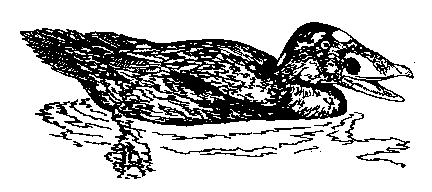
Qugaangi{ - Melanitta nigra Qugaangi{, ala}um sangis akus, udang hasinal iga{tazanas akus, wayaam liisnazalaka}is. Qugaangim ali}ingis hakangis qaxchikdazas. Hagumataku{ hiiyukagan kangaa chumnugim angalidigaa angali{taza{. Hawakus qugaangim ayagangis chumnugim qaxchikdaa angali{tazas. Qugaangi{ tunul aguun hmigala}na{ liidal tunuza{, agiichigaan uku}aIakan a{tagaliku{ umang tununaa tutalgaza{. Qugaangis, tamgaalus ilagaan sam chuqudanaa{tangis azas. Hagumatakus i}atuu}utakus, mayaa{talganaa{s agungis tamgaalus ilagaan ana{ maasaatunaza}ulas. Ala}um sangis malganangis ilagaan qalgangis qaatunazas. Qugaangis saaqudikinga udaa}anas agudix, qan'gim huzuu udang ahligudix qanikinga masxal aguun chugaanul hamang ilan angiqamdix hadan huyal, aqadagudix taaman saahmla}izas, udang saahmla}iza}ulas. Atuung aaka{ saahmla{tazas. Black Scoter - Melanitta nigra The common scoter is a saltwater duck. At one time, they were very numerous in this area. Nowadays, they are fewer in number. The drake has black feathers and a yellowish knob on top of its bill. The hen, on the other hand, is all brown. The common scoters make a whistling sound. They are sometimes heard even if they are not visible. They are smaller in size compared to the white-winged scoter. They are harder to hunt than the white-winged scoter because they spook very easily. They are among the better eating ducks of the saltwater birds. They spend the winters here in the Aleutians. They arrive in the fall and return to where they came from in the spring. They go north to their nesting grounds. They do not nest around this area. |
Black-legged Kittiwake:
Tiigilgaada{ - Rissa tridactyla Tiigilgaada{, sluka{ liidam sa}akuchanaa aku{, slukam ilagaan chuqudaza{ ama tunuu ila{taa itxa{taa}utaza{. Tiigilgaadas udang liisnaza}ulas, slum aslaan uhlii haang iga{tal qakuchas qakus uku}azas. Udang al slunas agudix, saaqudikinga masxal aguun chugaanul uku}aqadazas. Haang ala}um achidan qakuchas qakus uku}azas. Slum aslaan hakang ala}um qusan iga{tana{ liidal angali{ aguun, qa{ ukumasuguum hakaax itna{ liidal ala}um ilan chla}na{ aguun, qakucha{ kixtal kuu}aza{. Tiigilgaada{ uku}al aguun, hakangis quhmal ama quuhmliix angali{taza{, aku{ igasigan chuqikix hakangis qaxchikdazas, ama kitakix ila{tangis qaxchikdazas. Slum aslaan saahmla}il agungis, isxangis qahngum qakangis ilagaan agu}izas. Hagumatal iganas ilan agacha saahmla}izas. Slum ilan tiigilgaada{ alax saahmlax aguza{. Saahmlakix chid}aayuna{ liidaku{ tu{ila}izax.
Black-legged Kittiwake - Rissa tridactyla The Kittiwake is a bird similar to a gull, but it differs by its size and its sound. Kittiwakes are kind of rare here. They are seen only during the summer feeding on small fish. The Kittiwakes spend their time here only during the summer. When fall comes, they head back south for the winter. The Kittiwakes are seen feeding on small fish near the beach during the summer. They can also be seen flying up in the air, and all of a sudden, you will see them fall out of the sky into the water just to come up with a fish in their beaks. When a Kittiwake is seen, its feathers are white and grayish in color, and its wing tip feathers and legs are black. Kittiwakes don't nest around here but they make a nest of seaweed on the ledge of the sea cliff. Their eggs are spotted. Each female lays two eggs. |
Bufflehead: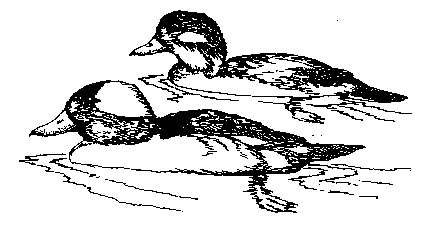
Midimit{i{ - Becephala albeola Midimit{i{ hanim sakuchaa amaku{, hanim sangis malganangis ilaan chuqudaza{. Midimit{im ali}ingis quhmakus qaxchikdaa}utazas, kamgingis chid}ina{ liidakus, chid}aayuu}utazas. Midimit{im ayagangis kaaxadgim sa}anagan ayagangis liidaaguzazas, akus kaaxadgim ilagaan chuqudaa}utazas. Sakucham hasinal iga{taatungis azas. Hanis asxuunulax udam chi}ana}ingis ilan al qanagnas agudix, qanikinga masxal aguun chugaanul uku}aqadanas agumdix, saaqudikinga masxal aguun, udaa}aa}utazas. Hanim sagan qaatunangis akus, hitmilgangis i}amanaa}utazas, hingamakus maalal kalulgaakal agungis kalulgazakus. Bufflehead - Becephala albeola The bufflehead is a freshwater duck. It is smaller in size than the other freshwater ducks. The drake is white and black. The head looks bluish green. The hen has a closer resemblance to the harlequin duck, but it is smaller in size. Even though these ducks are small, they like to fly in great flocks. After spending their winters in the lakes, or small bays with little creeks, they go north in the spring. In the fall, they return to this area once again. They are tasty ducks. They are also easy to pluck. That is why whenever they can be shot, they are shot. |
C |
|---|
Common Eider:
Kasami{ - Somateria mollissima Kasami{ al}um sangis malganangis ilagaan angunazas. Hagumatakus kasamim ali}ingis quhma{ ama qaxchikda{ angali{takus, kitangis ama hiiyukangis kanuuyam angalidigaa angali{tazas. Kasamim ayagangis chumnugim qaxchikdaa angali{tazas. Qan'gim aslaan sakang ala}um ilan al qanagnas agudix, saaqudgi{ amaatxaqadal aguun tana{ adaa}aasal saahmla}ii}dix agacha anuxtaqalizakus. Hawakus tan}is uuquchiingi}ulangis agatingis kugan saahmla}izakus. Ti}yum adungis ilan isxa{ agu{tal ilan saahmla}izas. Isxangis chungus ama qiigas ilagaan agu}izas. Kasami{ atuung saahmla{taza{, saahmlangis chid}aayum angalidigaa angali{tazas. Hawakus kasamim chiidangis migal a}al agudix kukutus ngaan asa}al hagumaalazakus. Slum aslaan saahmla}il agudix sadagikus maalal ti}yum ilan alaaza{siilal aygaxs sulalgazakus. Saahmlangis agiitangis lalgal, aqadaguun, qalgazakuu maalal hagumaalazas. Hamahliim chungungis lalgal, aqadgungis qiigaa hagyayal ilaan kahngiitis aguzanas, aku}aan wayaam qigulgazalaka}is, Amilaayam kahngiitingis agatingis wayaam su}azakus. Kasamim ali}ingis slum aslaan sadaglaka}is, hawakus ayagangis agatingis sadagzas. Saaqudikinga masxal aguun kasamim ali}ingis chngulil hakangis txidix isxanal agudix ana{ mal iga{taakalaka}is, sadagii}utazas. Hawakus ha}aa}us ilan aslixsxal agungis anagili{ su{tal lalgazaqas hiiIa{tazas. Wayaam haqaya}azalaka}is. Common Eider - Somateria mollissima The eider is one of the larger saltwater ducks. The drake is black and white. Their feet and bills are yellowish in color. The hen is all brown in color. During the winter, the eiders spend their time way out at sea. When spring comes, they approach land and get ready to lay eggs. They prefer nesting on islands that do not have any foxes. They nest in the long grasses. The nest consists of grass and down. They usually lay six eggs which are light green in color. When the egg hatches, the baby is called kukutu{. During the summer, the eiders and their eggs are gathered. The technique used for doing this is to walk quietly along where the birds are nesting. As soon as one is spotted, it is grabbed with both hands. This is how the duck and the eggs are caught and eaten. Some time ago, the eider down was collected and used for making pillows. Now, however, the whiteman made pillows are used. The drakes are not fat during the summer, but the hens are. In the fall, however, the drakes when shedding their feathers, are very fat. During this time, they cannot fly. They are then cornered in small lagoons and clubbed, so they say. This method is not used any more today. |
Common Goldeneye:
Hanim Kamgituu - Bucephala clangula Hanim kamgituu hanim saa amaku{, agiichigaan hanis kda}ilakan agungis hanis ilan uku}aza{, ala}u{ ila{taa tana{taa}utaza{. Hanim kamgitugan ali}ii sam quhmagan sugdanana{ liidaa aza{. Hachii qaxchikdal kamgii chid}aayul, kamgii angunana{ liidaa}utaku{ maalal hanim kamgituu hiila{taza{. Hanim kamgitungis kitakix chumnugim qaxchikdana{ liidaa angali{tazas. Hanim kamgitugan ayagaa quuhmliix angali{tana{ liidaku{, quhma{ ila{taa aa}utaza{, hingamataku{ kamgii chumnugim qaxchikdagan i}duxtana{ liidaa angali{taza{. Sam i{atungis azas, hagumatakus ay{aasi{ umang tunuku{ tutal agudix igazas, hagumatakus maalal ahmi}angis axsxangis kayu}nanaa{tazas. Iga{tal agudix izanaza}ulas, quhmana} liidakus slachxiza{ malgal aguun, igasingis hmigala}na{ liida{ agu{tazas. Udang alanazana}ulas aku}aan, wayaam Ilisnazalakas. Udang al qanaxs aqadagudix, qanikinga masxal aguun chugaanul aqadagudix ilan saahmla}izamchix ilan saahmla}il aqadagudix, saaqudikinga udaa}aa}utazas.
Common Goldeneye - Bucephala clangula The common goldeneye is a freshwater duck. Whenever there is no ice on the lakes, they are seen there. They also spend their time in saltwater. The drake is a fancy looking white duck. Its back is black. It has a green head. Its head looks very large and that is why the Aleuts call it the lake's big head. Its feet are yellowish black. The hen is grayish. Its bottom side is white, and its head is brownish. The goldeneyes are easily scared away. All it takes to set them off flying is the noise of a running motor. That is why they are hard to hunt. They are identifiable easily when in flight in good weather. When they are in flight, they look whitish and their wing beats can be heard whistling over head. They used to be plentiful around here, but nowadays that is not the case. The goldeneyes spend their winters here, and come springtime, they go north to their nesting grounds. After laying their eggs, they return again in the fall. |
Common Loon: Qigu{ - Gavia immer Qigu{ saI}u{ aku{, aIa}um ilan al aguun hamang kiduxtana{ liidaza{. Qan'gim aslaan qigu{ chuqagan ilagaan ilidaa akiita{ quhmaza{, aku{ kangayuu qaxchikdaza{, hingamataku{ hiiyukam chutxidigaa mataza{. Slum aslaan hakangis txidix isxanal aguun, angalingis txidix isxanazas. Kamgingis txidix chid}aayutil ama hachigan hangadan huzuugizaa quhma{ tu{ila{taasaqalizas. Sas malganangis ilagaan sam chlaqatuu aza{. Chla{tal amaatxa{ hnuza{. Sam chlaqatungis akus hakangis amnil hiila}aza{, mal qigu{ mataza{. Hakangis hitmilgangis amnizas. Hingamaku{ mal qigu{ uxilgalakan aguun, taangam akinagan ilan a}aI aqadaguun taaman hitmilgal aguun hakaa amniza}ulax. Qigu{ qalgal aguun isu}im ilagaan txin hikitaza}ulax, huzugaan qakuchas qazaku{ mal, qanuna{ liidaza{. Slum aslaan hanis tan}i}ingis ilan agach saahmla}izas. Slum huzuu udaan ahmi}a tana{tazas. Qan'gim aslaan ala}um kugan haang uku}azas, aqadaguun slu{ masxal aguun saahmla}ikus mal uku}ayaxsxaza}ulas.
Common Loon - Gavia immer The common loon is a large bird. When it is seen on the water, it looks as though it is lying in it pretty low. During the winter, the loon is white from beneath its throat down to its abdomen. Its back is black, and it has a very sharp bill. During the summer, the loon changes its color. The head turns green and the back gets full of white spots. It is often said that birds that dive have very tight feathers, and they are hard to pluck. The loon is this kind of a bird, and it is hard to pluck. If the skin of these birds is not stripped off them, the loon is kept in hot water to make the feather plucking chore easier to do. When the loon is eaten, its flesh tastes very similar to a seal. This is because it feeds on fish, and it has a fishy taste to it. During the summer, the loons make nests on small islets in the lakes. The loans stay around here all year round. During the winter, the loons can be seen often in the water. In the summer, however, they are hardly seen because they are usually nesting at that time. |
Common Murre: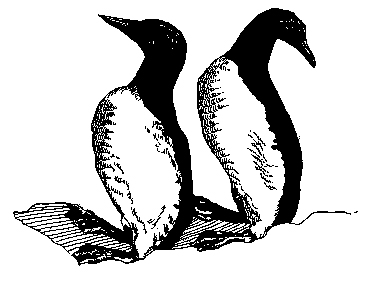
Ulungt{a{ - Uria aalge Ulungt{a{ (Sakita{), ala}um saa aku{ hachii ama kamgigan huzuu qaxchikdaku{, chuqagan ilaan ilidaa akiita{ quhmaza{. Ulungt{am hiiyukaa chutxidigal ama qaxchikdaza{. Slum aslaan iganas ama ala}um achidan adungis ilan saahmla}izas. ala}um kugan al agungis agiichigaan txidix as hasinal haang akus uku}azas. Sam ala}um qamdagan ilan aatungis azas, chlaqatuu}utazas. Qagaan unangangis agatingis qa{takan hiila{tazas. Wang At{am kugan qalgazaIaka}is, slum aslaan imya{sxal aguun, um}i}ilgalakan aguun, agiichigaan uIungt{a{ kalu}al um}i{talgazaku{. Slum aslaan saahmla}il aguun, ataqan uhlii saahmla{taza{. Hagumatakus kalulgazalaka}is mal, slum aslaan hasinal haang iga{takus uku}azas.
Common Murre - Uria aalge A murre is a saltwater duck. It has a black back and head, and white feathers from the throat to the belly. The murre's bill is sharp and black. During the summers, the murres nest on the cliff sides and inside the caves along the shores. When they are seen on the water, they are usually in big flocks. A murre is a duck that likes being in deep water, it is also a diving bird, and it is told that the Eastern Aleuts eat them. Here on Atka, murres are not eaten. During the summer, if someone goes out deep sea fishing and does not have bait, the murres are shot and used for bait. During the summers, the murres lay only one egg. Since they are not shot for food during the summer, they can be seen flying around in great numbers. |
Common Raven: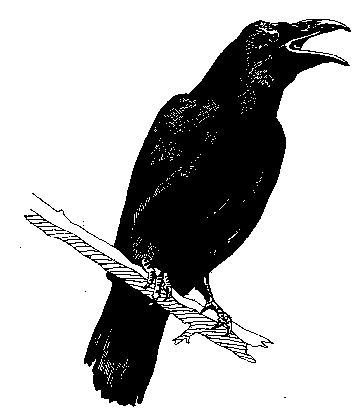
QangIaa}i{ - Corvus corax Qanglaa}i{, sam huzuu qaxchikdaa aku{, tanam saa aza{. Kitangis qaxchikdakus qagal}ingis aduu}utazas. Wan sa{ alaaza{silgaa haqataza}ula{, huzugaan tununa{ Iiidaza{. Qanglaa}i{ iga{tal aguun ila{taa ilagaan ida}aza}ula{, hakang inkam ilagaan itmigna{ liida{ agu{tal agiichigaan iga{taza{. Sam qaagus ilan aatuu aza{, qaagus hyusxaqas agungis ilan al qaatuza{. Sas malganangis ilagaan itaangil saahmla}izas, iganas ilan isxa}izas, isxangis ala}um achidagaan qahngum qakangis ama iiklaygis ama qiigas ilagaan agu}izas. Qanikinga malgal agiichigaan qaniix malgal aa}aku{ saahmla}izas. Qanglaa}i{. Siching asxuunulax uluung aaka{ saahmlas mataza{. Saahmlangis chid}aayuna{ liidakus tu{ila}izas. QangIaa}is udang al slum huzuu agzas.
Common Raven - Corvus corax The raven is a black land bird with feet that have sharp claws. This bird does not know what being quiet means. It seems to be always cawing. When a raven is flying, it is easily identifiable by the dives it makes. It sometimes looks as though it is going to fall to the ground, but it never does. A ravens likes being around garbage and waste. Whenever garbage is dumped, they feed on it. Among all the birds, the raven is the first to lay eggs. The raven's nest consists of dried seaweed, sticks and grass. The nest is usually situated on a cliff. Sometimes in the fall, even if it is snowing, the raven lays eggs. It lays four to seven spotted eggs. Ravens are present all year around. |
Cormorant:
Aagayuu}i{ - Phalacrocorax pelagicus Aagayuu}i{ or Aagayuu{, sam uyugan aduu aza{. Hingamataku{ kamgikucha{ mataza{. Aagayuu}im huzuu qaxchikdaza{. Hiiyukaa iIa{taa adul ama ichaaqidal agalungis iga}iisi{ liidaza{. Sam chla{taatungis azas, chla{tal qakuchas mayaa{takus mal hagumazas. Agiichigaan haang tanam angan uchiginangis uku}azas, higitina{ liidal chla}zas. Hitxingis ila{tangis aduzas. Aagayuu}is agiichigaan hasinal haang quganam kugan akus uku}azas. Ala}um kugaan iganaa{s aguun txin kayu}asana{ liidaza{. Slum aslaan hawakus iganas ama adus ilan saahmla}izas. Isxangis qahngus ama qiigas ama agiichigaan kingdam ilagaan agu}izas. Saahmlangis chid}im angalidigaa angali{tazas. Saahmlangis unalgal aa}akus qangana{ liidaza}ulas hiila{tazas. Hagumatakus chiidangis a}al agudix haka}iiguzaza}ulas, qach{idigana{ liidazas. Aagayuu}is udan agacha tana{tal sluzas. Hamahliim aslaa qalgakuu alakan aguun kalu{tal qalgazaqas hiiIa{tazas. Wayaam haqaya}azalaka}is.
Pelagic Cormorant - Phalacrocorax pelagicus The cormorant is a bird with a long neck. It also has a very small head. It has a long narrow bill that looks like the edge of a hand-saw. Cormorants like diving. They dive for fish, and that is why they dive so much. Sometimes they can be seen diving near the shore. When they dive, they look like they are leaping out of the water and then down under it again. They have long tails. Sometimes the cormorants are seen resting on the rocks in great numbers. When a cormorant is seen trying to take off from the water, it really looks as though it is having a hard time. During the summers, the cormorants nest on the sides of the cliffs. This is where they lay their eggs. The nests are made out of seaweed and grass, and sometimes twigs and branches. The eggs are light blue in color. When the eggs are cooked, they appear not to be cooked at all, so I have been told. When the eggs hatch, the babies do not have very much down. They really look very skinny. These birds live here year round. Long ago when food was hard to get, the cormorants were shot for food. Today, however, they are not eaten. |
E |
|---|
Emperor Goose: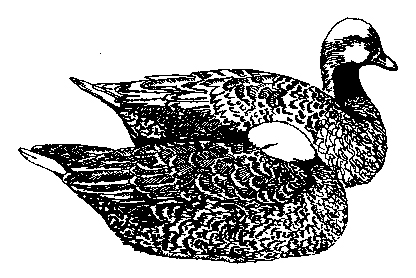
Qagmangi{ - Philacte canagica Qagmangi{ sas malganangis ilagaan angunaza{. Qan'gim aslaan uhlii uku}azas. Chugum hadan al sluqadagumdix, qan'gi{ masxal aguun, chugum hadan txin kdaqaliguun, asla qakungis alaka}is mal udaanul udakus tan}is ilan al qanagzakus. Qagmangi{ uku}al aguun, hawakus qagmangim anangis kamgingis quhmadigakus uku}azas, ama husigan sitxagaan uyugan kaduu}ii akiita{ qaxhikdaza{, hachii ama atxulii quuhmliigiku{, hakangis chutxingis qaxchikdazas. Hagumatakus kitangis kanuuya{ angali{tana{ liidazas. Qagmangim hlangis hiila{tanangis anadix liidakus chuqudanaa{tazas. Aadahliikakus kamgigan angalingis qaxchikdana{ liidazas. Kitangis ila{tangis kanuuya{ angali{tana{ liidakus amayaknana{ liidaa}utazas. Udang al qanagigudix hawakus ala}um achidan qahngungis ama iklus qa{tal an}a}izas. Qan'gim aslaan agu}i{ amgaan agach a}a{tazaku{ mal, qal amagnas agumdix chi}anakuchas hnu{tal taangazakus. Hagumal agungis, an}a}inas tugida}il aguu taanganisazakungis. Udang al qanagnas agumdix qanikinga masxal aguun txidix ixchilaqalizakus. Udang al txidix sadaxs anas mal txidix chugaanuqalizas. Hagumatakus chugum hadan agach saahmla}izas. Qankus asxuunulax qamchiing saahmla{tazas. Saahmlangis quhmazas, ama isxangis chungu}izas. Chugum hadan an}a}inangis agatingis slum aslaan qagmangis saahmla}igungis saahmlangis la{tal qazas hiila{tazas.
Emperor Goose - Philacte canagica The emperor goose is among the larger birds seen in Atka. They are seen only in winter. They spend the summers up north and return to the Aleutians during the winters. The reason why they migrate to the Aleutians is because when it freezes up north, they have nothing to eat. Therefore, they search for open water where they find food. The emperor goose adults have heads that are white. It is black below its jaw to its front. The back and belly is grayish in color. Their feet are yellowish orange in color. The immature geese are exactly the same coloring except they are smaller in size. Their heads are also full of black spots. The feet on the immature ones are kind of faded as opposed to the bright ones of the adults. When the emperor geese spend their winters here in the Aleutians, they feed on seaweeds when it is low tide at night. After they feed, they go to drink water in small streams. When they drink water in the streams, the men hunt them. When the moon is out, the hunters wait for the geese where they go to drink water. As soon as the geese land to drink water, the men shoot them. The geese stay here until spring, then they head back north. They are very fat when they head back north because of all the food they eat during the winters in here in the Aleutians. The emperor geese nest up north. After heading back north, they lay from three to eight eggs that are whitish in color. I have heard that the people up north gather goose eggs for food during the summer. |
G |
|---|
Glaucous-wing Gull: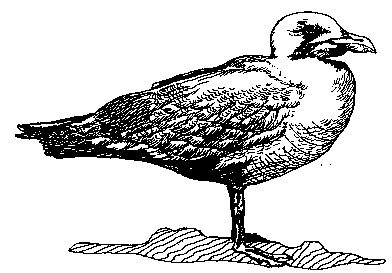
Sluka{ - Larus glaucescens Sluka{ sa{ aku{ quhmal ama quuhmliigim angalidigaa angali{taza{. Slukas udaan ahmi}an al slum huzuu agzas. Slum aslaan qakungis alanaIak}is mal tanadgusim ahmi}an uku}aza}ulas, aadahliikakus tan}is kugan saahmIa}ikus mal liisnaza}ulas. Aqadaguun qan'gi{ masxal, aslaan qakungis liisnaqadagungis tanadgusim ahmi}a agacha tana{taaguzazas. Qaagus ala}um achidan hyusxanangis akus qazakus mal tanadgusi{ agacha ahmi}a}izas. Slukas slum aslaan tan}im uuquchiinga}i}ulangis kugan saahmla}izas. Hagumatal agungis, ayuxtanas al saahmlangis qalgaa{ lalgazakus, saahmlal}uchxizas matazas. Saahmlangis chid}aayum angalidiganaa{taa akus qaxchikdakuchas tu{ila{taasazas. Slukam isxangis qiigas ilagaan agu}ikus, agiitingis qayas kangan akus, agiitingis quganas kugan azas. Qankus saahmla{tazas, saahmla}iiguzaqalil agungis lalgal agungis, saahmlam hagyangis atxazalgaza{, agalikul lalganaa{s agungis chiidatul i}amanaza}ulas. Slukas agatingis ana{ qanaa{s aa}aza}ulas, ulu{ asxuunulax hamaax atxazaakanadix atxazal qazas. Slukam chiida{taqangis akus chyaalis hiila{tazas, quuhmliigim qaxchikdaa angali{takus. Slukas quhmadigakus uku}angis hagyaachxuzana{ liidazas. Glaucous-wing Gull - Larus glaucescens The gulls are white and gray birds. They are present all year round. During the summer, the gulls are not seen in great numbers near the village because they have lots to eat. They also nest on the islands. When winter comes, however, they stick around the village because they do not have much to eat. They wait for scraps of food whenever someone empties his garbage. The gulls nest on islands without foxes during the summer. Their eggs are gathered for food at certain times of the year. They are good-sized eggs. They are olive with black spots all over them. The gull nest is made from grass and moss. They usually have three eggs. It is best to gather the eggs after the first few days of being laid, or else they will be incubated. The gulls are not choosy eaters. They eat meat and whatever they can find to eat. The young gull is called chyaali{. It is gray in color. The mature gull, on the other hand, is whitish and looks like it has been washed clean. |
Gray-crowned Rosy Finch:
Chaanu{ - Leucosticte tephrocotis Chaanu{, sakucha{ amaku{, aku{ qalgaza}ula{ agacha. Chaanum hakangis chumnugim qaxchikdaa aku{ ama uluudam angalidigaa ila{taa angali{taza{. Chaanum kamgii ila{taa quuhmliix angali{taza{ ama hiiyukaa chumnugiza{. Slum huzuu chaanus udang akus uku{azas. Slum aslaan saahmla}izas, iganas asxuunulax ulaaklus a}iilaqangis ilan saahmla}izas. Isxangis qiigas ilaan agu}izas. Hawakus chaanum chiidangis hagil iga{taqalil agudix anadix liidakus akus, kamgingis agatingis quuhmliigiza}ulas. Hawayangis akus kamalus ngaan asa{tanas azangis. Chaanus iga{tal agudix inkam ilan higich{ina{ liida{ agu{tal aga{tazas. Gray-crowned Rosy Finch Leucosticte tephrocotis The finch is a small bird which is not eaten. The feathers on a gray-crowned rosy finch are brownish, and also pinkish in color. The head is gray and the bill is yellow. The finches are present here all year around. The finches nest during the summer on cliffs or old abandoned buildings. The finch nest is made of grass. As the young finches grow up they look like their mothers except that they do not have gray crowns. Aleuts call the young finches kamalus. When the rosy finch flies it looks as though it is jumping up and down in the air. |
Green-winged Teal:
Qii{chiida{ - Anas crecca Qii{chiida{ hanim sakuchaa amaku{. Hanim sangis malganangis ilagaan chuqudaza{. Qii{chiidam ali}ingis ayagamdix ilagaan hakam sugdanangis matazas. Kamgii chumnugim qaxchikdaa aku{, dagan chida}an chid}aayuza{, aasal huzuu quuhmliigina{ liidaku{ quhmaa}utaza{. Qii{chiidam ayagangis huzuu hizax chumnugim qaxchikdaa angali{tazas, akus hingakus igasigan agalangis utmaa aaka{ akiita{ amasuku{, hakam chid}ingis matazas. Qii{chiidas udaan ahmi}an al slum huzuu agizas. Qan'gim aslaan hanis kda}il agungis, chi}anas asxuunulax ala}um achidan tatungis ilan al qanagzas. Aqadaguun slum aslaan hanis ilan haang akus uku}azas. Slum aslaan udahligan saahmla}izas, hanis chida}an asxuunulax tan}ikuchas kungin ila{tangis saahmla}ii}utazas. Isxangis chungus ama qiigas ilagaan agu}izas. Qii{chiida{ hati{ aaka{ saahmla{taza{. Slum agaIuu}ii chi}anas ilan al qas tutuunudix itxiqangis qal hagumahligudix, qanu{ txidix hitzas, mal qalganaa{sxal agungis qanuzas.
Green-winged Teal - Anas crecca The green-winged teal is also a freshwater duck. It is smaller in size than most of the freshwater ducks. The drake has fancier feather coloring than the hen teal. The drake has a brown head and it also has green near the eye region on the sides. Its body is grayish in color, and it has green feathers on the middle back of its wings. The bottom side is white. The hen is brownish in color, and it has blue feathers on the middle back of its wings. The green-winged teals are present here all year round. During the winter when the lakes are iced up, the teals can be found in the creeks, or the tide pools near the beach. During the summer, they are seen around the lakes. The teals nest here on Atka. They either have nests around the lake area, or on small islets. Their nests are made of down and grass. They lay approximately ten eggs a year. |
H |
|---|
Harlequin Duck:
Kaaxadgi{ - Histrionicus histrionicus Kaaxadgi{ ala}um sakuchaa aku{, kaaxadgim ali}ii ayagaam ilagaan sas matazakungis mal hakangis sugdanaza{, hakangis chid}ina{ liidaku{ kay igasikix sitxan chumnugim qaxchikdaa aza{, ama hachigan ama alugan angakix quhma{ tu{ila{taasaza{. Kaaxadgim ayagangis hawakus midimit{im ayagangis hizax Iiidakus, midimit{im ilagaan angunaa}utazas, ama igasigan agalan utmakix hakam quhmangis mataa}utaza}ulax. Udang al slum huzuu agza{, udaan saagamagii aza{. Saaqudikinga ama qan'gim aslaan agacha kalulgazakus. Saaqudgim ama qanikinga angi}azalaka}is, aa}an hakangis txidix isxanal chuqidugikus, mal ana{ maalal hitimilgal hayasxaakalaka}is maalal hingaan aslaan haqaya}aza}ulas. Kaaxadgis udaan ahmi}an alanalaka}is uku}azas, hagumatakus haang ala}um achidan agacha aaguzazas. Slum aslaan hakangis txidix isxanal agudix ana{ mal iga{taakalaka}is agiichigaan uku}azas. Hagumatal agudix ala}um hangadan xaadagnaa}ina{ liidazas. Slum aslaan saahmla}izas, aku}aan an}a}inam saahmlaa ilganaa as{aan ilgal hiila{taku{ tutazanaq.
Harlequin Duck - Histrionicus histrionicus The harlequin duck is a saltwater duck, and the drake like other drakes have fancier feathers then the hen. The drake has bluish feathers and brownish underneath the wings with white spots on its back and its sides. The hen is very similar to the bufflehead hen, but it is larger in size. Unlike the bufflehead, the hen has white feathers in the middle of the back of its wings. These ducks are present here all year round. They are shot during winter and fall. But they are avoided during the summer and spring because they are full of pin feathers and they make plucking difficult. Lots of harlequin ducks can be seen quite often around here. They are also seen along the shore swimming. During the summer when their feathers are changing, they cannot fly. If you approach them when they are in this situation, they seem to run along the top of the water when they are fleeing. The harlequin ducks lay egges during the summer. I used to hear that if someone looks for harlequin duck eggs, he is looking for his own death. |
Horned Puffin: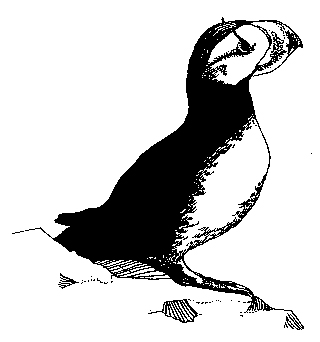
Qagida{ - Fratercula corniculata Qagida{ sam uxchu{ liidaa aku{. Slum aslaan udang uku}azas, slum sagan itaanginaaguzaa al udaa}aza{ hiila{taku{ tutazaqang. Sam liisna}ulangis al hiila{tazas mal matazas. Sam qaxchikdaa aku{ sagima}ii ama ilidaa huzuu quhmaza{. Qagidam hiiyukaa hanatuku{, qichi}ii}utaza{, hiiyukaa uluudana{ liidaku{ aku}aan kanuuyaa}utana{ liida{ angali{taza{. Hagumatakus tan}is kugan hunas agu{tal ilan slum aslaan saahmla}izas. Slu{ inal saaqudikinga masxal aguun uqis ilagaan hawaa}aqamdix hadan huyaa}utazas. Uku}alakan qanagnas agudix qanikinga masxal aguun txidix udaa}atii}utazas.
Horned Puffin - Fratercula corniculata The horned puffin is similar to the tufted puffin. They are seen during the summer. I heard that the horned puffin is the first summer bird to arrive here during the summer. Horned puffins are seen in small numbers. They aren't abundant like other birds. The horned puffin is a black duck with a white face and belly. It also has a thick, sharp kind of reddish orange beak. During the summers, horned puffins make burrows in the ground on islands where they nest and have eggs. When fall comes, they return to where they came from, to come back again the next spring. |
K |
|---|
King Eider:
Saaku{ - Somateria spectabilis Saaku{ aIa}um saa amaku{, kasami{ hizax liidaku{ kasamim ilagaan itxa{taa}utaza{. Kasamim ilagaan chuqudaku{. Saakum ali}ingis kasamim ali}ingis hizax liidakus, hakangis kasamim hakangis ilagaan angalingis sugdanaa}utazas. Kamgingis hakam sugdanangis ku{tazas ama hakam qaxchikdangis ama quhmangis mataa}utazas. Hingamataku{ hiiyukaa kanuuyam angalidigaa angali{taku{ an}usigan kangan takda}ina{ liidaa}utaza{. Saakum ayagangis kasamis liidaaguzakus ilagaan chuqudanaa{tazas. Qan'gim aslaan udang anas agudix qanikinga masxal aguun chugaanul uku}aqadaa}utazakus, saaqudikinga masxaa}utal aguun kuu}azas. Qan'gim aslaan kalulgal qalgamazakus, hitmilganaa{sxal agudix, qach{ingis ihmiituzas. Saakum ali}ingis liisnalaka}is ayagangis agatingis hasinal udang akus uku}azas.
King Eider - Somateria spectabilis The king eider is a saltwater duck which resembles the common eider. It is different though. First of all, it is smaller in size than the common eider. The drake is similar to the common eider, but it has fancier coloring. Its head has dark fancy head feathers. Its bill is yellowish, and it looks as though it has a large orange knob on the top of its nose. King eiders spend their winters here in the Aleutians. In the spring, they go back north and spend the summers there. They again return here in the fall. The eiders are shot during the winters for food. They are hard to pluck because the skin tears off when the feathers are being plucked. There are usually more hens than drakes. |
L |
|---|
Lesser Scaup: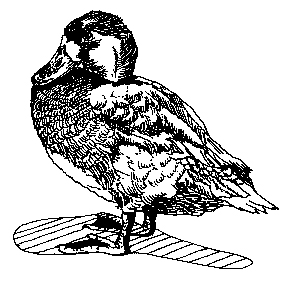
Kuchutu{ - Aythya affinis Kuchutu{ hanim saa aa}utakum, aIa}um ilan agach aaguzaza{, hagumataku{ hasinal iga{taatuzas. Taga{tal agudix uku}angis qaxchikdana{ liidakus, iga{tal agudix ilidangis quhmakus uku}azas. Kuchutum ali}igan kamgii chid}aayuna{ liidaza{ aku{ hawan kuchutum ayagaa chumnugim qaxchikdaa aku{, hiiyukaa chid}im angalidigaa angali{taza{ ama hiiyukagan chuqii hakangis quhmaza{. Hawan udam qamdana}ulangis chi}ana}ingis ilan aatuzas. Qan'gim sangis agacha azas, udang al qanaxs aqadagudix, qanikinga masxal aguun, chugaanul uku}aqadaa}utazas. Hagumatakus igal agudix aa}i{ liidal igaza}ulas, igal agudix ala}um kugan xaadagnaa}ina{ liidahligudix igazas. Kuchutus udang saahmla}iza}ulas mal saahmlangis angali{tanangis haqatalaka}ning.
Lesser Scaup - Aythya affinis The lesser scaup is a freshwater duck but it is found mostly in salt water. Scaups like to fly in large flocks. When they are on the water, they look dark in color, but once they are in flight, their bottom sides are white in color. The drake has a green head and the hen is brown. Their bill is light blue, and it has a white feather on the base of it. Scaups like living in the lagoons, or small bays where there are small creeks. The lesser scaups are winter ducks. They migrate here during the fall and when spring comes, they return to where they come from. I have never seen an egg of a lesser scaup so I don't know the color of it. |
M |
|---|
Mallard:
Aa}i{ - Anas platyrhynchos Aa}i{ hanim saa hiila{taza{. Hanis ilan uku}azaku{ mal, agiichigaan hanis txidix kdal}iI aguu, hawang ala}um achidan tatungis ilan aku{ uku}aa}utaza{. Hanim sangis hakangis hitmilgangis agatingis amnilaka}is maalal mayaa{tanas aatuzangis, ulungis ila{taa tunga}ilakan qaatunazakus mal. Aa}i{ hanim sangis malganangis itagaan angunaza{. Hingamataku{ aa}im ali}ingis agatingis ayagamdix ilagaan hakam sugdanangis matazas, kamgingis chid}aayuna{ liida{ angali{tazas ama hinga uyugan sitxagaan kimlaa akiita{ hakangis chumnugim qaxchikdaa angali{taku{, hachii quuhmliigina{ liidaku{, hitxigan kangan hakam qaxchikdagan qihmu}ii mataza{. Aa}im ali}ingis ayagamdix ilagaan angunanaa{tazas. Sam iga{tal aguun axchigangis azas. Hagumatakus iganilgal agungis, hakang inkam ilan hangal aqadagudix taaman kadmuda}an txidix ay}atzas. Udang agiitingis saahmla}izas, hawakus hanis ahmi}ingis saahmla}izas. Isxangis chungu}ikus qamchiing asxuunulax hati{ aaka{ saahmla{tazas. Mallard - Anas platyrhynchos The mallard is a freshwater duck. This duck can also be seen near the beach in small tide pools when all the lakes are frozen. Freshwater ducks are easier to pluck. That is why the people like hunting for them. The meat is also tender and good to eat. Mallards are among the larger freshwater ducks. The drake is larger than the hen. The drake also has very fancy coloring. Its head is green, and its front from its throat to its breast is brown. Its back is gray, and a black curled feather can also be seen on top of its tail. The mallard is a very fast flying bird. When a mallard takes to flight, it goes straight up and goes forward once it reaches a certain height. Some mallards nest here on Atka near the lakes. Their nests are made out of grass and down. They lay eight to ten eggs. |
O |
|---|
Oldsquaw: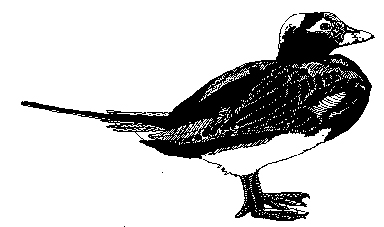
Aanglaa}i{ - Clangula hyemalis Aanglaa}i{ ala}um saa aku{, sam quhma{ ama qaxchikda{ angali{taa aza{. Hagumatakus hasinal txidix as haang taga{tal asxuunulax iga{takus uku}azas. Aanglaa}im hiiyukaa adulaka}im qaxchikdal ama uluudam angalidigaa angali{taza{. Aanglaa}im ali}ingis hitxingis adul ama chutxidigana{ liidazas, hawakus amtatum ali}ingis hitxi{tanangis liidaguzas hitxitamazas. Aanglaa}im ayagangis hitxingis aduza}ulas. Aangla}is agiichigaan sakang saakaatxan ala}um ilan akus uku}azas, hagumatakus sam chla}migiitungis azas. An}a}inas mayaa{tal agungis sakang aIa}um ilan al chla}mixs agungis, hamang ala}um ilan chla{s agungis ay{aasi}iisal hadan huyal hnul qasanangis mataasal kalul lazangis, hagumatakus sakucham as{aatu}ulangis azas. Ala}um sangis malganangis ilagaan hitmilgangis haada{tazas, hanim sangis ilagaan hakangis amninaa{tazas. Udaan ahmi}an al qanagnas agudix qanikinga masxal aguun chugaanul ilagaan hawaa}aqamdix hadan huyaa}utazas. Saaqudikinga masxaa}utal aguun udaa}aa}utazas. Tunul agudix, "Haagal angaliq. Haagal angaliq." Hi{taaguzana{ liidazas.
Oldsquaw - Clangula hyemalis The oldsquaw duck is a saltwater duck. The feathers are black and white in color. They are sometimes seen on water in big flocks. They are in big flocks too when they are flying. The oldsquaw duck has a short beak. The beak is black and pink. Like the drake for the pintail, the drake oldsquaw has a sharp long tail. The hen, on the other hand, does not have a long tail. Sometimes the oldsquaw ducks are found in great numbers out at sea. They are divers and they do a lot of diving. The way to catch them is to approach them with a boat when they are diving. When they surface, they are shot. They are very strong, and they are hard to kill. Among the saltwater ducks, the oldsquaw is one of those that is easier to pluck. They are still harder to pluck, however, than the freshwater ducks. The oldsquaw ducks spend the winters around this areas and come spring, they go back north where they come from. They again return here during the fall. When the oldsquaw duck is quacking, it sounds like it is saying, "Haagal angaliq. Haagal angaliq." This means in Aleut "I was hungry today." |
P |
|---|
Pigeon Guillemot: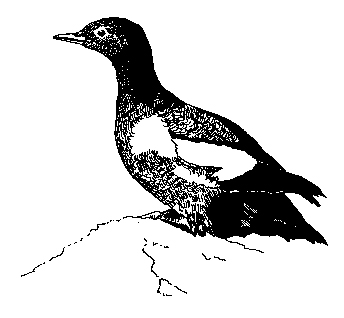
Siihmlu{ - Cepphus columba Siihmlu{, sakucha{ aku{ slum huzuu udang uku}aza{. Sakucham huzuu qaxchikdaa aku{, igasigan agalan utmaa aaka{ amasuku{ hakangis quhmaza{. Sakitam hiiyukaa liida{ mataza{. Slum aslaan hawakus kuchis quchigingis saahmla}izas, saahmlangis ukulgangis kayu}nal hiila{tazas. Siihmlum kitakix uku}al aguun uluuda{ ama qaxchikda{ angali{tazax. Siihmlu{ qalgaakaku{ aku{ hakangis chuqidugil ana{ maalal hitmilgal hagyasxaakaza}ulax hiila{taza{. Sakucham tunul aguun hmigala}na{ liida{ agu{taa aza{. Siihmlum chiida{taqangis qan'gim aslaan uku}al agungis anamdix ilagaan itxa{tazas, huzungis quhmana{ liidazas. Uku}al agungis hizax aanglaa}im ayagaa lisngizas. Saaqudikinga haang alanalaka}is uku}azas.
Pigeon Guillemot - Cepphus columba The guillemot is a small duck that is present here all year round. The guillemot's feathers are all black, except for the feathers on the back middle of its wings which are white. The guillemot has a bill similar to the murre. During the summers, the guillemot's nest is among the boulders and the eggs are very difficult to get at or to find. The color of the feet on the guillemots look kind of redish and black. It is said that the guillemot can be eaten but it has too many pin feathers and that makes it difficult to pluck and so it is avoided as much as possible. The guillemot is a small duck with a whistle-like cry. The young guillemots, during the winter, are seen around here, and they differ from their mothers. They look all whitish and are somewhat similar to an old squaw hen duck. Pigeon guillemots are very plentiful during the summer. |
Pintail:
Amtatu{ - Anas acuta Amtatu{ sam aa}i{ as hizax txin Iiidaa aku{ aa}im ilagaan chuqudanaa{taza{. Hagumataku{ amtatum aIi}igan kamgii chumnugim qaxchikdaa aku{, hachigan hakangis quuhmliix angaIi{tazas. Amtatum ali}igan hitxii adul chutxidigana{ Iiidaza{. Amtatum ayagaa aa{im ayagaa hizax Iiidaku{ ilagaan chuqudaa}utaza{. Amtatus hanis kda}iIakan agungis ilan akus, hanis txidix kdaI}iI agungis ala}um achidan tatungis ilan akus agiichigaan uku}azas. Udaan ahmi}an aa}dagaIikus uku}aI liisnaalaza}uIas. Amtatu{ igal aguun aa}i{ matal igazanaa liida}utaza{, hakang inkam ilan hangal aqadaguun, taaman kadmuda}an txin iga{taqaliza{. Qan'gim aslaan agacha udang azas, slum aslaan udang azas amasukus haqatalaka}ning. Slum aslaan saahmla}il agudix atuung asxuunulax hatim alax saahmla{tazas.
Pintail - Anas acuta A pintail is very similar to a mallard but is smaller in size. The drake has a brown head, and a grayish back. It also has a sharp long pintail. The hen, on the other hand, appears exactly like a mallard hen but it is smaller in size. Where there is no ice on the lakes, the pintails are usually present there. When the lakes are iced up, they could be seen along the shore where there are tide pools. The pintails are present around this area but they are hardly seen. The pintails take to flight in exactly the same way as the mallards. They go straight up, and once they reach their altitude, they start going forward. The pintails are here during winter. I don't know whether they are here in the summer. During the summer when they are nesting, they produce six to twelve eggs. |
R |
|---|
Red-breasted Merganser:
A}laaya{ - Mergus serrator A}laaya{ hanim saa aku{, hanim sangis malganangis ilagaan itxa{taa}utaza{. A}laayam hiiyukangis i}i}idal adukus, iga}iisi{ liidaa}utazas, kanuuya{ angali{takus, sam qas qa{tangis lakus mal hiiyukangis hiikus ngaan agu{izas. Uku}anaa aagayuu}im hiiyukaa hizax liidaaguzaza{. A}laayam ali}ii hakangis sas matazakungis mal sugdanaza{, kamgii chid}aayul hachii qaxchikda{ ama quhma{ aza{. Hiiyukaa ama kitakix uluudana{ liidaza{. A}laayam ayagagan hachii quuhmliigina{ liidaku{, kamgii chumnugim qaxchikdagan i}duxtana{ liidaa aku{, ilidaa quhmaza}, ama igasigan agalan utmaa aaka{ akiita{ hakangis quhmaza{. A}laayas udang al slum huzuu agzas. Hanim sangis matazakungis mal mayaa}sxanaa{s agungis i}atul ahmi}angis axsxaakaza}ulas. A}laayas qakuchas qa{tazakus mal una}al qalgal agudix qanuna{ liidazas. Saaqudgim aslaan udang isxa}il, saahmlas matazakus. Hanis asxuunulax tan}is uuquchiingi}i}ulangis kugan, kingtim sitxan asxuunulax ti}yum adugan ilan saahmIa}izas. Qamchiing asxuunulax hati{ aaka{ saahmla{tazas. Saahmlangis uluudam angalidigaa angali{tazas. A}laayam saahmlangis chiidatulakan agungis qalgazas.
Red-breasted Merganser - Mergus serrator The red-breasted merganser is a freshwater duck, but it is different from the other freshwater ducks. They have long thin orange bills that look like the edge of a saw blade. They feed on fish so their bills are well adapted for that purpose. The drake, like many of the other duck species, has very fancy feathers. Its head is green, and its back is black and white. Its bill and feet are reddish orange. The hen, on the other hand, has a kind of grayish body feathers. Its head is brown. Its belly side feathers are whitish. The middle part of its wings are white. The mergansers spend all year here, and like the other freshwater ducks, they are very difficult to hunt. This is because they can be spooked very easily. Because the merganser feeds on fish, it has a fishy taste when it is cooked. The mergansers nest here during the summer. They nest near the lakes on the islands without foxes. Their nests are usually found under a grassy bank, or in the long grasses. They lay from eight to ten eggs a year. The eggs are pinkish orange in color. They can be eaten if they have not been incubated for long. |
Red-faced Cormorant: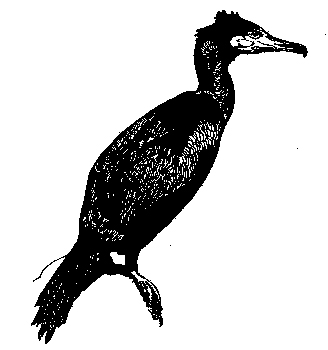
Ingatu{ - Phalacrocorax urile Ingatu{, aagayuu{ liidaaguzaku{ sagima}ii agacha uluudaza{, ama kahnuliisim quhmakix karmaanil}itana{ liidaza{. Slum aslaan hakangis angalingis chid}aayuna{ liidazas. Hagumatakus agiichigaan ala}um achidan igana}ingis ilan isxa}izas, asxuunulax hasam qayanaa{tangis kugan saahmla}izas. Aagayuu}im isxa{tanangis liidas isxa{tazas. Qankus asxuunulax siching saahmlam chid}igan angalidigangis saahmla{tazas. Kadim hadagaan taya}us ay{anangis asla qakungis alakan agudix, hasas kugan aagayuu}is asxuunulax ingatus sa}al agungis amgaax hadan huya{tal cha}iisal suzanas hiila{tazas. Sulal agudix ataqan quganam ngaan tukluxch{il aguun, agitaadat igach{izaku{ maasal, alaaza{siisal sulazaqangis hiila{tazas. Ingatus udaan ahmi}an slum aslaan aIanaza}ulas, qalgayaxsxazalakas maalal kalulgaza}ulas.
Red-faced Cormorant - Phalacrocorax urile The red-faced cormorant has a red face even though it is very similar to the Pelagic cormorant. It has two white spots toward the back of its sides. This makes the bird look like it's carrying white handkerchiefs in its pockets. During the summer, the red-faced cormorant's feathers look greenish. Sometimes they nest on cliffs which are their rookeries. Their nests are similar to the Pelagic cormorant. They lay three to four eggs. These are light blue in color. |
Red-throated Loon:
Qaqa}i{ - Gavia stellata Qaqa}i{ sam qigu{ liidaa aku{ qigu}im ilagaan chuqudaza{. Ala}um kugan aguun hamang kidu{tana{ liidaza{. Qan'gim aslaan hachigan hangadan hakangis quuhmliixs chuqagan ilagaan ilidaa akiita{ quhmaza{. Hingamataku{ qigu{ liidal hiiyukam chutxidigaa mataza{. Sam qigu{ liidaa aku{ mal, sam chlaqatuu amaza{. Hagumatal chla{tal qakuchas mayaa{tazakus mal chlaqatuzas. Sam chlaqatungis akus hakangis amnil hiila{tazas mal qaqa}i{ mataza{. Qigu{ liidam sa}anaa aku{ maalal, mayaa{talgal liisnaalaza}ula{, aadahliikaku{ hitmiitunazalaka{ mal. Ala}um kugan aku{ achunanaa{talakan aguun igaakaza}ula{. Aa}an qakuchas qal txin kayagnatiku{ mal. Qaqa}is slum aslaan hanim tan}ikuchangis kugan saahmla}izas. Slum aslaan hakaatxan inkam ilan iga{tanangis tutalgazas qa-qa-qa-qa, hi{tal iga{takus ilgalgahliguun hakang iga{takus uku}azas. Tunugan amil}an ilagaan aku{ asaa ngaan asaalaqa{ amasuku{, hingamaku} mal qaqa}i{ ngaan asa}azaku{. Red-throated Loon - Gavia stellata The red-throated loon is very similar to a common loon except it is smaller in size. When seen on water, it sits very low in it. During winter, the red-throated loon has gray feathers on its back and it has white feathers beneath its throat, all the way to its stomach. It has a very sharp bill like the common loon. The red-throated loon is a diver like the common loon. It dives for fish which it eats. It also has tight feathers, and it is very hard to pluck. Because of this, it is not hunted much. Sometimes the red-throated loon has a hard time trying to fly if there is no breeze. This is because it is heavy from eating fish. These birds nest on lakes where there are small islets. During the summers, these loons can be heard crying up in the sky while they fly. The sounds they make are qa-qa. It is possible to spot them first from the sounds they make. They probably got their name from the sound they make. |
Rock Ptarmigan:
A}diikas - Lagopus mutus A}diika{, tanam sakuchaa aku{ udaan ahmi}an huzugaan al sluzas. Sakucham qan'gim aslaan hakangis quhmal aku{ hitxigan alugan angakix qaxchikdaza{. Slum aslaan hachigan kugan hakangis zuulutu{ angaIi{tana{ liidal, kamigan alugan angakix qamikix uluudana{ liidaza{. Sas malganangis ilagaan itxa{taza{, kitakix huzuugizakix imli}ina{ liidazax. Hagumatakus hawakus aangsum kingdangis qa{tal an}a}izas. A}diika{ alax kimla{taza{, chuqagan sitxan kimla{ matanaam uglagaan kangchi{ ila{taa mataa}utaza{. Saaqudikinga ama qan'gim aslaan agiichigaan kalul qalgazakus. Qalgal agungis it{aygi{ qalganaa liidaaguzazas. Qan'gim aslaan hasinal txidix as iga{takus uku}azas, aqadagudix slum aslaan chisalal alax al haang aqalizakus, hagumatal saahmla}ii}dix agacha anuxtaqalizakus, qamchiing asxuunulax hati{ aaka{ saahmla{tazakus. A}diika{ igal ama tagal aguun tunuza{, mal agiichigaan uku}alakan aa}aku{ umang tutalgaza{. Sakucha{ akum tunuu qamdal chuqaa qaklagiikana{ liidaza{. A}diikam isxaa; sas isxangis agudigakus a}diikam isxaa mataza}ulax, qiigam adunaa{tangis ilan isxa}izas.
Rock Ptarmigan - Lagopus mutus The ptarmigan is a land bird which stays here all year round. It is white in color and the tail sides are black in winter. During the summer the ptarmigan is kind of golden on the sides. Its sides of its head are red and orange in color. The ptarmigan is different from other birds because its legs are covered with feathers. It feeds on berries. It has two stomachs. One is used for storing food, and the other is used for digestion and is called a gizzard. The ptarmigan is sometimes shot during the fall or winter for food. When it is eaten, it tastes something like reindeer. During the winter, the ptarmigan fly in by flocks, and when spring comes, they fly in pairs thinking of having eggs. They lay eight to ten eggs a year. The nest is a poorly lined hollow on the tundra. The ptarmigan cries when it takes off, and when it lands. So even when it is not seen, it can be heard landing or taking off by just its sound. For a small bird, it has a deep voice that sounds dry and brittle. |
Rock Sandpiper: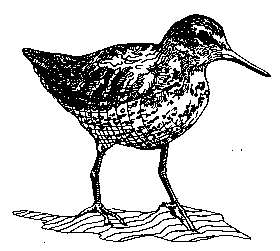
Chulixta{ - Calidris ptilocnemis Chulixta{, sakucha{ aku{ haang chugum kugan asxuunulax, quganas kungis uku}azas. Uku}al agungis hakangis quuhmliix angali{tana{ liidazas, iga{tal agungis igasingis quhmal ama qaxchikdakus uku}azas. Qan'gim aslaan hasinal txidix as iga{takus uku}azas, iga{tal agungis hingaanu{tal aqadagungis udaanu{tanas liida{ agu{tal iga{tazas. Chulixtas hawaa tanam ilan hunakucha{ agu{tal nagan isxa}izas. Siching saahmlam chid}aayugan angalidigagan tu{ila}ii aaka{ saahmla{tazas. Chulixtas liidas haang malgakus, itxa{taa}utazas, smii}is chulixtas liidanaa{takus aku}aan chulixtas ilagaan angunaa}utazas. Chulixtas slum huzuu udang azas. Slu{ masxal aguun tanam qudgan agacha saahmla}izas, tanam chi}il}i}ingis asxuunulax kii}uusis ilan saahmla}izas. Slum aslaan hakagan angalingis txidix isxanal chumnugim qaxchikdaa, quhma{ ama qaxchikda{ angali{tazas. Chulixta{ tunul aguun hmigala}na{ liida{ agu{taku{ tutalgaza{. Hagumataku{ slum aslaan isxagan ahmi}a axsxamasuguu tunul alquna{ liida{ agu{taza{.
Rock Sandpiper - Calidris ptilocnemis A rock sandpiper is a small bird usually seen on sand or rocks. When a sandpiper is seen it looks grayish in color. When in flight its wings are black and white. During the winter they fly in great flocks, when flying they seem to go side by side zig-zagging as they fly. There are other sandpipers that are similar to the rock sandpiper, but they are different. Among these are the smii}i{ which is larger than the rock sandpiper. They lay their eggs in a hollow on the mossy tundra. About four olive-buff spotted eggs are laid. The sandpipers are present all year round. During the summer, the sandpipers nest near swamps or on top of the high hills. They change color in the summer to brownish, black and white. When the sandpiper calls, it can be heard making whistling sounds. Sometimes during the summer, maybe when their nests are approached too closely, they fly around making all kinds of noise. |
S |
|---|
Snow Bunting: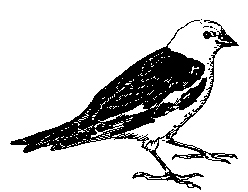
Maadugaa{ - Plectrophenax nivalis Maadugaa{, madugaa}is sakucham qayas kangan tana{tangis azas. Hakangis quhma{ ama qaxchikda{ angali{tazas. Qan'gim aslaan agiichigaan utal ala}um achidan hnu{tal qakus uku}azas, qaniixtu{ ama qingana{ malgal aguun taaman ala}um achidan uku}azas. Slum aslaan kii}uusis kungin aygaxsxal aguun aku}azas. Kii}uusis agatingis ilan saahmla}izas. Atuung aaka{ saahmla{tazas. Maadugaa}is slum huzuu udan tana{tazas.
Snow Bunting - Plectrophenax nivalis Snow buntings are small birds that can be seen usually on the mountains. Buntings are black and white in color. During the winter when it is very snowy and cold, buntings can be seen feeding along the beaches near the shore. During the summer, they can be seen on the mountains when you go hiking. Snow buntings nest around here, and they lay approximately six eggs. They are present around here all year round. |
Snowy Owl: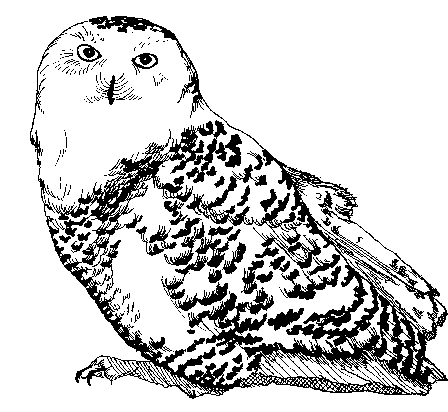
Tutuutu{ - Nyctea scandiaca Tutuutu{, sa{ amaku{, ti}la{ hizax liidaku{ aku{, kamgii angunana{ liidaku{, dakix ila{takix angunaa}utaza{. Hagumataku{ sagima}ii hamang hingu}ina{ liidaza{, ama hiiyukaa du{ta{ liidaku{, kitakix ti}lam kitakix liidaza{. Tutuutus, kriisas chilus ama qas qa{tal an}a}izas. Tutuutus amgim sangis azas. Amgaax haang iga{tal qaqamii}uzas hiila{tazas. Qaxchikdam sinigan ukuqadigakus mal, amgaax agacha manadix mazas hiila{tazas. Udang uku}a{ liisnaalaza}ulas, chugum hadan saa aku{ agiichigaan qan'gim aslaan uku}azas. Tutuutus qalgal hiila{tana{ tachim tuta{ta}ulaq.
Snowy Owl - Nyctea scandiaca A snowy owl is a bird similar to an eagle but it has a large head and eyes. An owl looks as though its face is pushed in, the beak is hooked and it has claws like those of an eagle. Snowy owls feed on mice, rats, birds and also fish. Owls are night birds, they fly during the night hunting for food, even when it is a dark night. Snowy owls are not seen around here very often. They are seen sometimes but only during the winters. |
Song Sparrow: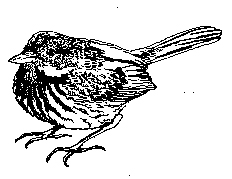
Chiixuyaaka{ - Melospiza melodia Chiixuyaaka{, sakucha{ aku{ qatxayam ilagaan angunaza{. Hakangis qaxchikdana{ liidakus, quuhmliix ana{ liidaa}utazas. Slum aslaan kingtim sitxan saahmla}izas, siching aaka{ saahmla{tazas. Slum huzuu udang uku}azas. Qatxayam hitxii liidanaa{taa mataku{ aku{, qatxayam hitxigan ilagaan aduza{. Qilam qilaa{ angali{ haqaqaliguun umang ulam kangan tunukus agiichigaan tutalgazas. Qan'gim aslaan haang ala}um achidan akus uku}azas. Sakucham angaachi}iituu aza{.
Song Sparrow - Melospiza melodia The song sparrow is a small bird similar to a wren, but is is larger. The song sparrow has kind of darkish colored feathers; and it looks rather grayish also. During the summers, the sparrows have nests underneath grass mounds. They lay approximately four eggs yearly. Sparrows spend all year here. They do not migrate like other kinds of birds. The sparrow's tail is similar to the wren's but lengthwise, the sparrow's tail is longer. Sometimes in the early mornings, they are heard singing on top of the houses. During the winters, the sparrows are usually seen near the beach. |
T |
|---|
Tufted Puffin:
Uxchu{ - Lunda cirrhata Uxchu{, sam qagida{ liidaa aku{, uxchum ingyugan huzuu qaxchikdaza{, kamgii agalan qaxchikdaku{ sagima}ii quhmaza{ ama qamikix quhmal aduza{. Uxchum hiiyukaa qagidam hiiyuka{tanaa liida{ aza{, tumtatuku{ kanuuya{ angali{taza{, kitakix ila{taa kanuuyam u}a{taa liida{ angali{taza{. Uxchu{ slum saa aku{, slum aslaan udang al saahmla}il aqadaguun saaqudikinga masxal aguun hadagaan angiqaam hadan huyaa}utaza{. Uxchu{ qagida{ liidaku{ tan}im kugan asxuunulax iganas ilan huna{ agu{tal nagan saahmla}iza{. Hawan azaatakus uku}azakungis saahmla}il agungis ataqan uhlii saahmla{tazas. Sakucha{ aku{ igasikix aduza}ulax. Kadim hadaan an}a}inas uxchum tanakix hnu{tal hunangis ilagaan igula{ maqa{tazanas a{tazakus. Uxchus lal aqadagudix uxil hakangis qigul, qakas aqadagudix ilagaan sax aguzaqangis a{takus, hawakux sax hiila{tana{ chu{taqa{ aku{ an}a}inam tukungis agatingis chu{tazaqangis hiila{tazaqas. Sisa{ aaka{ uxchu{ uxilgal aguun taaman ataqan sax ilaan agulgazaqa{ hiila{tazaqa{. Uxchu{ sakucha{ aku{, hitmiitunaza}ula{, hakangis amnikus mal, hingamataku{ maalal taangam akinagan ilan a}al aqadaguun hitmilgal aguun agacha amniza}ula{. Taangam akinagan ilan a}al hitmilgaatulakan aguun qach{ii uxilgal aqadaguun, hingamatal unalgaza{. Hingamasxal aguun qach{i}iqadal qalgal aguun itxa{taza{.
Tufted Puffin - Lunta cirrhata A tufted puffin is a bird similar to a horned puffin, but it is almost all black except for the face which is white. The eyebrows on a tufted puffin are long and white. The beak is of the same kind as the horned puffin, it is thick and redish orange in color. The feet are kind of faded orange in color. A tufted puffin is a summer bird. It lays eggs here during the summer and returns again to where it came from during the fall. The tufted puffin, like the horned puffin, nests in burrows which they have on cliffs or islands. Puffins lay only one egg a year. A tufted puffin is a small bird with short wings. Long ago people went to where puffins were nesting and gathered them by hand in their holes and used the skins for making what the Aleuts called sax. A 'sax' is a parka made only by the more wealthy class Aleuts. It is said that it took approximately 100 skins to make one parka. Tufted puffins are small birds but they are very difficult birds to pluck because the feathers are very tight. So the technique used to loosen the feathers is to dip them in hot boiling water and that makes it easier to pluck the birds. Then the other technique is to rip the skin off the puffin and it can be cooked that way. |
W |
|---|
Whistling Swan:
Qukin}i{ - Olor columbianus Qukin}i{, sal}u{ aku{ huzuu quhmaza{. Agiichigaan At{a{ agnangis uku}azas. Qan'gim aslaan agach agiichigaan uku}azas. Sal}um uyugan aduu aku{, hiyukaa ama kitakix qaxchikdaa aza{. Iga{tal agudix qagmangis liidal iga{tazas, hagumatakus agiichigaan udaan ahmi}a axs agudix hanikuchas ilan taga{takus uku}azas. Sal}us akus qi}unazas, kalulgaa{ matalaka}is, kaznam kalulgala}aa{ta{ matakungis maalal kalulgaza}ulas. Ataqadim lalgal hawaax hiisa{talgahlikus hizax inasxaqas a{takus mal wayaam liisnalakan hagumatazakus. Udaahadan saahmIa}iza}ulas, chugaanul aqadagudix chugum hadan agacha saahmla}izas. Tan}is asxuunulax chi}il}im ilan isxa}ikus, siching asxuunulax chaang saahmla{tazas.
Whistling Swan - Olor columbianus The swan is a large white bird that is sometimes seen flying near Atka. The swans are seen mostly in winter time. The swan has a long neck and it has a black bill and black legs. They appear like the geese when they are in flight. When the swans migrate through Atka, they are seen in the small lakes. These large birds are protected by the government. They are not supposed to be shot, so they are not shot. At one time or other, they were hunted almost to extinction so today, they are few in number. The swans do not nest as far south as Atka. They go north to nest. They nest on islands or near swamp areas. They have four or five eggs each year. |
White-winged Scoter: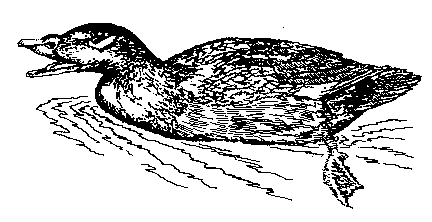
Tamgaalu{ - Metanitta deglandi Tamgaalu{ ala}um saa aku{, ala}um uhlii kugan aku{ uku}aza{. Tamgaalum ali}ingis hakangis huzuu qaxchikdakus, dagan imunagan hakangis quhmal, igasigan agalan utmaa hakangis ila{tangis quhmazas. Hingamataku{ kitakix ama hiyukaa uluudam angalidigaa ama qaxchikda{ aza{. Hagumatakus tamgaalum ayagangis, kaaxadgim ayagagan angunaa liidazas, chumnugim qaxchikdaa angali{tazas. Tamgaalus, sam aIa}um qamdagan ilan aatungis azas. Sas malganangis ilagaan chlaqatuzas, hagumakus mal hakangis hitmilgangis amnizas. Qan'gim aslaan hasinal haang anas agudix, qanikinga masxal aguun liisnaqadazas. Chugum hadan al slunas agudix. Saaqudikinga masxal aguun udaa}aa}utazas. Sam kayutungis azas, kalulgal ala}um kugan itxisxaqas agudix, hamang ala}um ilan chla{s uku}aqadazas. Tamgaalus udang saahmla}iza}ulas, chugaanul taaman hamang ilan saahmIa}izamchix ilan saahmla}izas. Tamgaalu{ hatim siching aaka{. Saahmlam uluudam angalidigana{ liidangis mataza}.
White-winged Scoter - Melanitta deglandi The white-winged scoter is a saltwater duck. This duck likes to stay in deep water. The drake white-winged scoter is all black in color. It has white feathers around the eye region. It also has white feathers on the back middle part of its wings. Its feet and its bill are pink and black in color. The hen is similar to a harlequin hen, and it is brown in color. The white-winged scoter is a duck that prefers the deep water. It dives more often than other ducks. It is also very hard to pluck their feathers. During the winters, they are seen in great numbers around the village. When spring comes, their numbers decline. They spend their summers up in northern Alaska, and they return to Atka once again in the fall. They are strong ducks. When the are shot, they dive underwater not to be seen again. They do not nest around this area. They go north to their nesting ground to have their eggs there. They usually lay about nine to fourteen pinkish eggs. |
Winter Wren: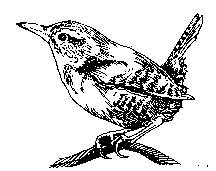
Qatxaya{ - Troglodytes troglodytes Qatxaya{, sakucha{ aku{ imudigana{ liidaza{. Hakaa chumnugim qaxchikdaa angali{taku{ ama dam qaxchikdaa ila{taa mataza{. Sakuchas udang malganangis ilagaan chuqudanaaguza{ aza{. Taga{tal aguun ataqam aslan alaka{, ataqan hiisa{tal samgamigina{ liidaza{. Hitxii iIa{taa hakang chuchagina{ liidaku{ uku}aza{. Qatxayas udang alanazana}uIas akuzaan, wayaam uku}al liisnaalazaqadakus.
Winter Wren - Troglodytes troglodytes The winter wren is a small bird that looks kind of round. The feathers on a wren are brownish in color. It has very dark black eyes. The wren is among the smallest of the birds seen around here on Atka. Whenever a wren is on the ground, it is continously moving. It seems as though it is always bobbing. The tail of a wren is always sticking straight up. There used to be lots of wrens around here, but they are hardly seen any more. |



 At{am Sangis
At{am Sangis